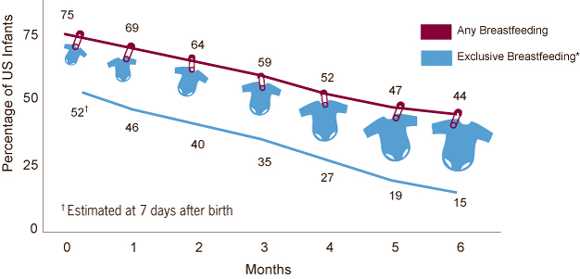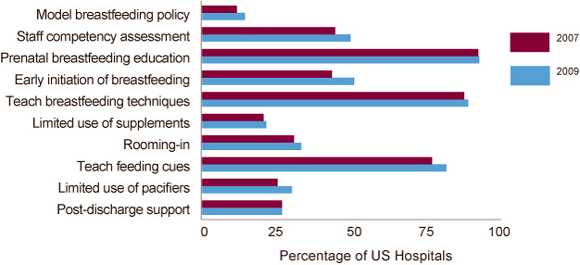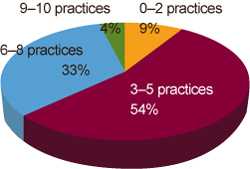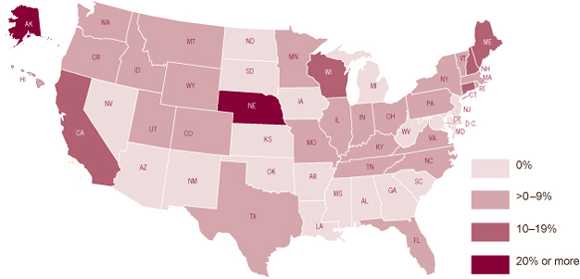Hospital Support for Breastfeeding
Preventing Obesity Begins in Hospitals
Childhood obesity is an epidemic. In the US, 1 preschooler in 5 is at least overweight, and half of these are obese. Breastfeeding helps protect against childhood obesity. A baby’s risk of becoming an overweight child goes down with each month of breastfeeding. In the US, most babies start breastfeeding, but within the first week, half have already been given formula, and by 9 months, only 31% of babies are breastfeeding at all. Hospitals can either help or hinder mothers and babies as they begin to breastfeed. The Baby- Friendly Hospital Initiative describes Ten Steps to Successful Breastfeeding that have been shown to increase breastfeeding rates by providing support to mothers. Unfortunately, most US hospitals do not fully support breastfeeding; they should do more to make sure mothers can start and continue breastfeeding.


30%
Breastfeeding for 9 months reduces a baby’s odds of becoming overweight by more than 30%.

1 in 3
Even mothers who want to breastfeed have a hard time without hospital support; about 1 mother in 3 stops early without it.

5%
About 5% of US babies are born in hospitals that are designated Baby-Friendly.
Problem
Most hospitals do not fully support breastfeeding.
Breastfeeding helps protect against childhood obesity and other illnesses, and lowers medical costs.
- The American Academy of Pediatrics recommends babies be fed nothing but breast milk for about the first 6 months and continue breastfeeding for at least 1 year.
- Babies who are fed formula and stop breastfeeding early have higher risks of obesity, diabetes, respiratory and ear infections, and sudden infant death syndrome (SIDS), and tend to require more doctor visits, hospitalizations, and prescriptions.
- Low rates of breastfeeding add $2.2 billion a year to medical costs.
- Mothers who breastfeed have lower risks of breast and ovarian cancers.
Hospitals should do more to help mothers start and continue breastfeeding.
- Hospitals that wait to start the first breastfeed, or separate babies from mothers, or routinely give formula to breastfeeding babies make it harder for mothers and babies to be able to breastfeed.
- When hospitals support mothers to feed their babies only breast milk, it helps mothers to continue feeding only breast milk at home.
Baby-Friendly hospitals make special efforts to support mothers to breastfeed.
- The World Health Organization/UNICEF Baby-Friendly Hospital Initiative, endorsed by the American Academy of Pediatrics, recognizes hospitals that follow the Ten Steps to Successful Breastfeeding.
- When hospitals have more of the Ten Steps to Successful Breastfeeding in place, mothers breastfeed longer.
The Baby-Friendly Ten Steps to Successful Breastfeeding
- Have a written breastfeeding policy that is routinely communicated to all health care staff.
- Train all health care staff in skills necessary to implement this policy.
- Inform all pregnant women about the benefits and management of breastfeeding.
- Help mothers initiate breastfeeding within 1 hour of birth.
- Show mothers how to breastfeed and how to maintain lactation, even if they are separated from their infants.
- Give newborn infants no food or drink other than breast milk, unless medically indicated.
- Practice "rooming in"— allow mothers and infants to remain together 24 hours a day.
- Encourage breastfeeding on demand.
- Give no pacifiers or artificial nipples to breastfeeding infants.
- Foster the establishment of breastfeeding support groups and refer mothers to them on discharge from the hospital or clinic.
Percentage of any and exclusive breastfeeding by month since birth among US infants born in 2008

*Exclusive breastfeeding = infant receives only breast milk and vitamins or medications, but no other solids or liquids.
SOURCE: CDC National Immunization Survey
Percentage of US hospitals with recommended policies and practices to support breastfeeding, 2007 and 2009

SOURCE: CDC National Survey of Maternity Practices in Infant Nutrition and Care (mPINC)
Percentage of hospitals by number of recommended policies and practices to support breastfeeding in 2009

U.S. State Info
Percentage of births at Baby-Friendly facilities in 2011, by state

SOURCE: Baby-Friendly facilities in 2011 and CDC National Center for Health Statistics 2009 Live Births
What Can Be Done
Federal government can
- Promote maternity care policies and practices that increase breastfeeding rates.
- Track hospital policies and practices that support mothers to be able to breastfeed.
- Help all federal hospitals implement the Ten Steps to Successful Breastfeeding.
State and local government can
- Set statewide maternity care quality standards for hospitals to support breastfeeding.
- Help hospitals use the Ten Steps to Successful Breastfeeding, starting with the largest hospitals in the state.
Hospitals can
- Partner with Baby-Friendly hospitals to learn how to improve maternity care.
- Use CDC's Maternity Practices in Infant Nutrition and Care (mPINC) survey data to prioritize changes to improve maternity care practices.
- Stop distributing formula samples and give-aways to breastfeeding mothers.
- Work with community organizations, doctors, and nurses to create networks that provide at-home or clinic-based breastfeeding support for every newborn.
- Become Baby-Friendly.
Doctors and nurses can
- Help write hospital policies that help every mother be able to breastfeed.
- Learn how to counsel mothers on breastfeeding during prenatal visits, and support breastfeeding in the hospital and at each pediatric doctor's visit until breastfeeding stops.
- Include lactation consultants and other breastfeeding experts on patient care teams.
- Coordinate lactation care between the hospital and outpatient clinic.
Mothers and their families can
- Talk to doctors and nurses about breastfeeding plans, and ask how to get help with breastfeeding.
- Ask about breastfeeding support practices when choosing a hospital.
- Join with other community members to encourage local hospitals to become Baby-Friendly.
Science Behind the Issue
Related Pages
- Vital Signs Issue details: Morbidity and Mortality Weekly Report (MMWR)
- CDC – Breastfeeding Promotion & Support
- CDC – Breastfeeding Report Card—United States, 2011
- CDC National Survey of Maternity Practices in Infant Nutrition and Care (mPINC)
- Childhood Obesity – Prevention Begins with Breastfeeding [PODCAST – 01:20 minutes]
- Obesidad infantil: la prevención comienza al amamantar a los bebés [PODCAST – 01:35 minutes]
- Childhood Obesity – Prevention Begins with Breastfeeding [PSA – 0:60 seconds]
- Send a Health-e-Card
- Winnable Battles
On Other Web Sites
- Page last reviewed: August 2, 2011
- Page last updated: August 2, 2011
- Content source:
- National Center for Chronic Disease Prevention and Health Promotion, Division of Nutrition, Physical Activity, and Obesity
- Page maintained by: Office of the Associate Director for Communications (OADC)


 ShareCompartir
ShareCompartir